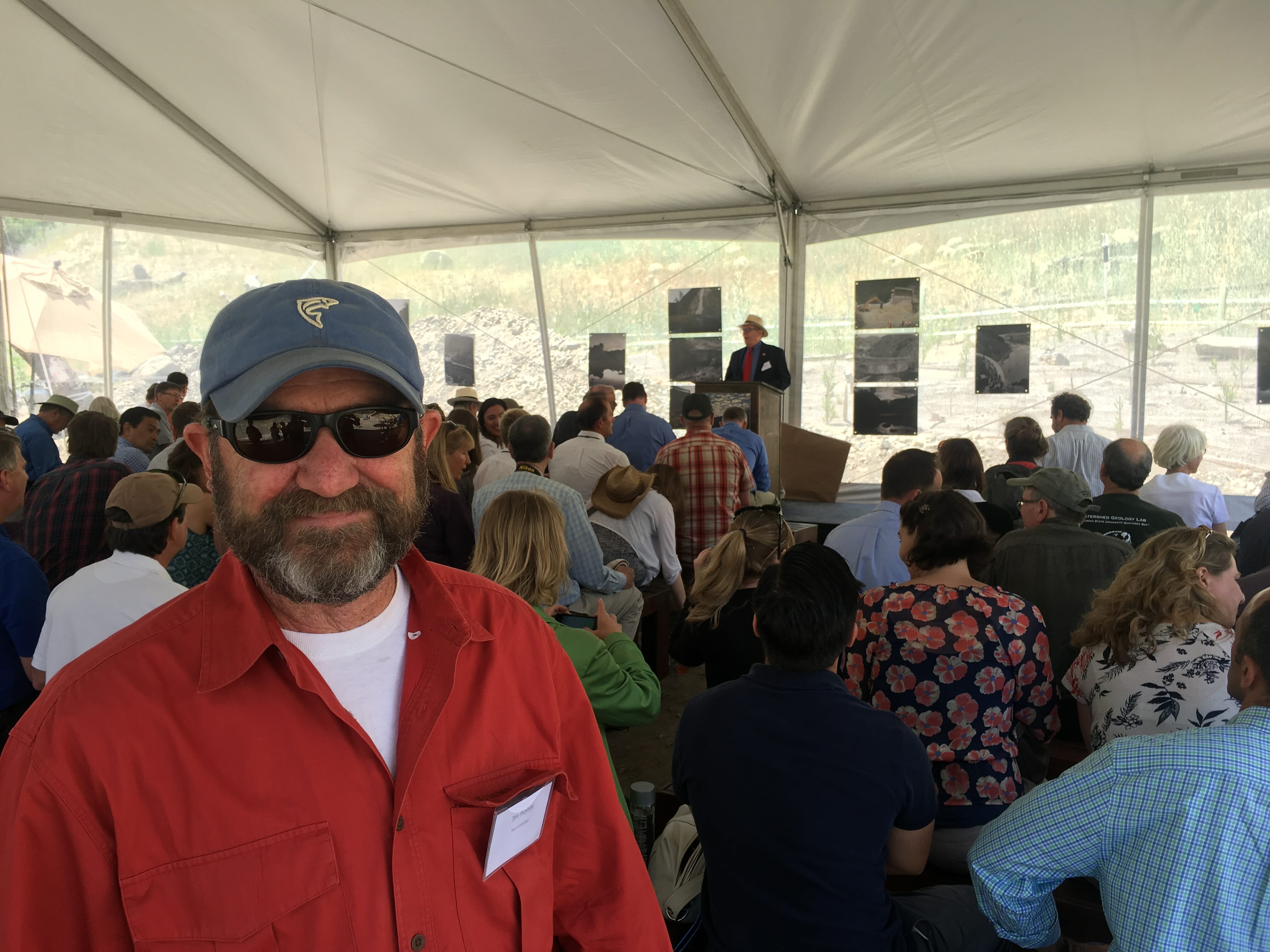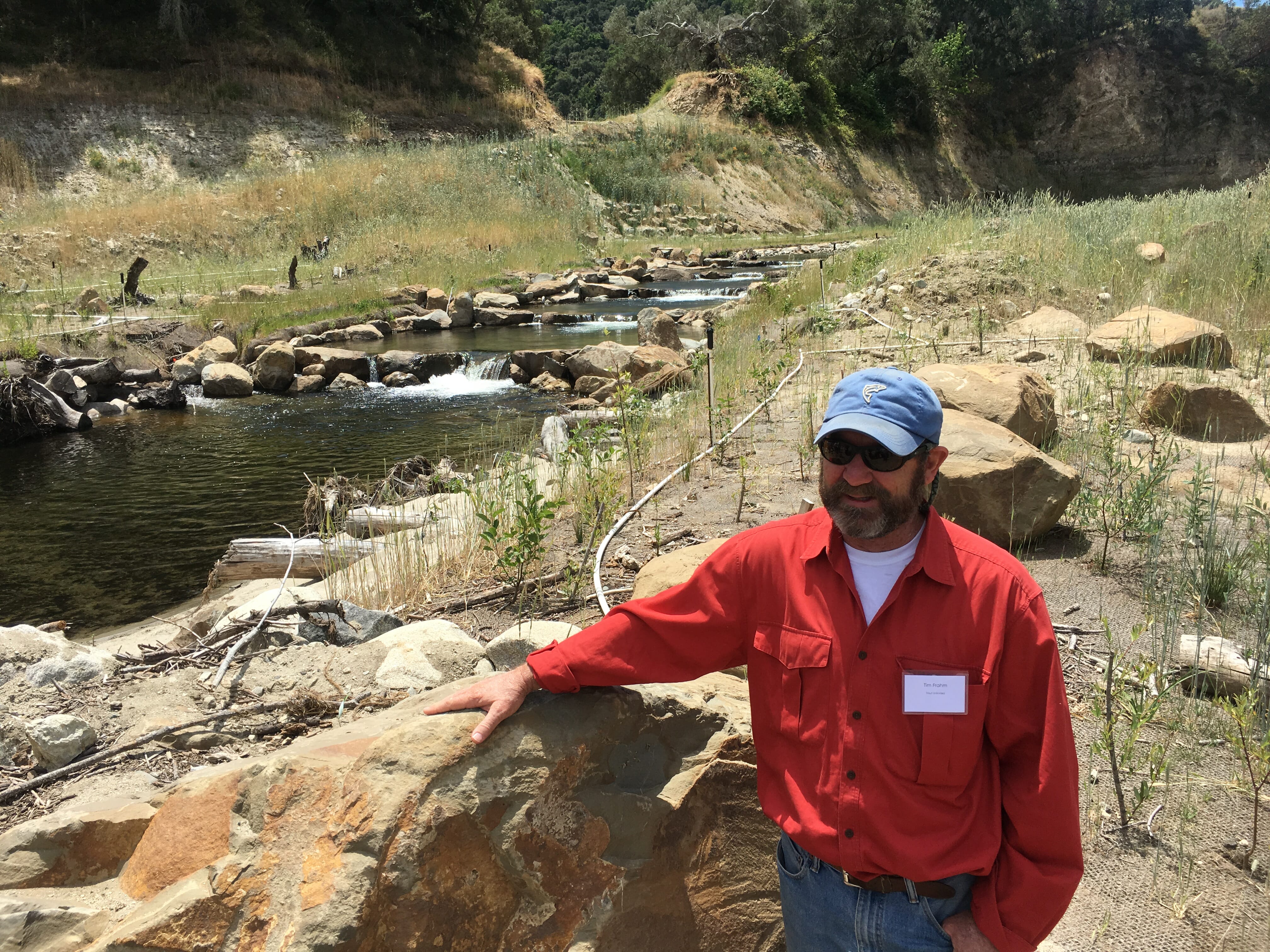Tim Frahm, Central Coast Steelhead Coordinator for Trout Unlimited, admires the newly restored Carmel River above the site of the old San Clemente Dam at the celebration event on June 6.
There have no doubt been many parties on the Carmel River, one of the best steelhead streams on California’s south-central coast, over the years. This scenic waterway has long been popular with residents and visitors for swimming, socializing, and fishing.
But it is unlikely that any of these festivities featured the gourmet hors d’oeuvres and host of elected officials and community leaders found at the party on June 6 on the upper Carmel River.Tim Frahm, CA state senator Bill Monning emceeing the celebration.jpg

(L) Tim Frahm enjoys the proceedings as CA State Senator Bill Monning emcees the event.
The cause for the June 6 celebration was a massive bit of destruction-a three-year project to take down San Clemente Dam (click here for a complete history and live video feed of the project). And the venue was somewhat unusual for events of this kind: the bottom of an old reservoir.
An impressive congregation of dignitaries attended this soiree. President of one of the country’s largest water providers. The representative for the 20th Congressional District. The California State Senate majority leader. Directors of federal and state resource management agencies. Executive officer of the California State Coastal Conservancy. A county supervisor.
And, of course, two representatives from Trout Unlimited.
In the early 1990’s, the California Division of Safety of Dams determined that San Clemente Dam, a 106-foot high concrete structure built in 1921, could potentially fail in a significant earthquake or flood event.
By 2006, when the California Department of Water Resources released a Draft Environmental Impact Report/Statement for the San Clemente Dam Seismic Safety Project, five alternatives had been developed to address San Clemente Dam’s safety issues.IMG_0350.JPG

The California-American Water Company, which owned the dam, preferred to keep the dam in place and strengthen it by pouring a whole lot more concrete.
(R) The new-look Carmel River, just above the site of the old San Clemente Dam. A remnant of the dam wall is visible as a white vertical band in the photo’s center.
The National Marine Fisheries Service (NMFS), a division of the National Oceanic and Atmospheric Administration, is charged with protecting and recovering the threatened south-central coastal distinct population segment (DPS) of steelhead trout. NMFS favored an option that would improve fish passage to the upper watershed.
Amazingly enough, a single meeting between Cal-Am and NMFS opened the door to the elegant solution of removing the dam. Cal-Am president Rob MacLean said at the June 6 celebration that he left that meeting nearly in tears, so moved was he by the “better way” of solving the company’s dam management challenges and restoring the fabled Carmel River at the same time.
The myriad problems dams create for migratory fish such as salmon and steelhead are well documented. But once a dam is in place it is typically very difficult to remove. Such endeavors require uncommon levels of agreement and collaboration between lots of politicians, agencies, businesses, and interest groups which are frequently at odds.IMG_0367.JPG

Taking out San Clemente Dam was no exception. TU’s Central Coast steelhead Coordinator, Tim Frahm, lauded the remarkable collaboration involved in the San Clemente Dam Removal and River Re-route Project in a blog from last fall.
(L) Tim Frahm and Brian LeNeve, president of the Carmel River Steelhead Association, discuss future angling prospects on the upper Carmel River.
TU played a small but vital role in advancing removal of San Clemente Dam from concept to implementation, helping to gain requisite approvals, raise funding, and build out public support.
At the June 6 celebration, Frahm gazed approvingly at the step pools engineered into the new streambed and wondered if we were allowed to wander further upstream, where we might find the steelhead redds that had been observed in the newly re-opened habitat.
We were not allowed to do that. But we were very satisfied that Carmel River steelhead, a wild population that has been decimated by habitat loss, water diversions and the current drought, were able to do so-just a few short months after the largest dam yet removed in California came down.
Sam Davidson is California Communications Director for Trout Unlimited. He grew up on the Carmel River.



